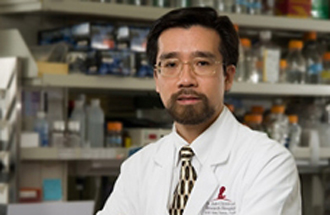Wing Leung Doubles Survival Rate for Leukemia Patients
Wing Leung has succeeded in more than doubling the survival rates for young leukemia patients who receive bone marrow transplants at St. Jude’s Children’s Research Hospital, as reported in the July 14 edition of the scientific journal Blood. The most impressive gains were seen by patients who lacked genetically matched donors.
These gains make transplantation a treatment option for more children and adolescents with high-risk forms of acute lymphoblastic leukemia (ALL) and acute myeloid leukemia (AML) who lack genetically matched donors, either related or unrelated.
“This study shows that transplantation offers real hope of survival to patients with high-risk leukemia that is not curable with intensive chemotherapy,” said Leung, M.D., Ph.D., the study’s principal investigator and director of Bone Marrow Transplantation and Cellular Therapy at St. Jude. Leung linked the gains to advances in cancer treatment as well as improved infection control and more sophisticated donor selection.
Five years after transplantation survival was 65 percent for the 37 St. Jude patients with high-risk ALL treated at the hospital between 2000 and 2007, compared to 28 percent for the 57 St. Jude ALL patients who underwent treatment between 1991 and 1999. ALL is the most common childhood cancer.
AML survival after transplantation rose from 34 percent for the 50 St. Jude patients treated between 1997 and 2002 to 74 percent for the 46 AML patients treated between 2002 and 2008.
During the same periods, there was an eight-fold reduction in infections, a four-fold drop in treatment-related toxicity and a 2.5-fold decrease in leukemia-related deaths. The overall survival gains coincided with an end to irradiation therapy for St. Jude leukemia patients, a treatment that is associated with a range of immediate and long-term side effects.
“We can now identify donors for virtually all pediatric patients who need transplant to cure their leukemia,” said Ching-Hon Pui, M.D., St. Jude Department of Oncology chair and the paper’s senior author. “Importantly, our transplanted patients not only have high cure rates but also excellent quality of life, resulting largely from advances in chemotherapy, donor selection and supportive care.”
Bone marrow transplantation involves destroying the patients’ own diseased blood-producing bone marrow and replacing it with hematopoietic cells from healthy donors. This study included three types of donors: genetically matched related donors; genetically matched unrelated donors; and partially genetically matched donors. Parents generally make up the third group, who are known as haploidentical donors.
The largest survival gains involved patients whose blood and immune systems were rebuilt with cells from haploidentical donors, i.e., their parents. Survival for these patients increased from 12 percent in earlier ALL and AML treatment eras to 88 percent in the most recent treatment era.
Historically, transplant patients fared best and suffered fewer complications when the donors were relatives who carried the same six proteins on their white blood cells. Known as HLA proteins, they serve as markers to help the immune system distinguish between an individual’s healthy tissue and diseased cells that should be eliminated.
St. Jude investigators pioneered the use of haploidentical transplants, demonstrating that careful matching of patients and donors and proper processing of the hematopoietic donor cells enhances the anti-cancer effect of transplantation without significantly increasing side effects. The process involves careful testing and HLA screening of potential donors to identify the parent whose immune system is likely to mount the most aggressive attack against remaining leukemia cells using specialized immune cells known as natural killer cells. The odds of finding a good haploidentical donor are 70 to 80 percent, compared to about a 25 percent chance of having a matched sibling donor, Leung said. The likelihood of finding a genetically identical, unrelated donor ranges from about 60 to 90 percent depending on the patient’s race or ethnicity.
Wing Leung received his M.D. from Hong Kong University and his PhD from Johns Hopkins. He is based out of the Memphis St Jude’s Children’s Hospital. His work has been focused on NK cell and stem cell transplantation and the late effect and molecular epidemiology
St. Jude Children’s Research Hospital is internationally recognized for its pioneering research and treatment of children with cancer and other catastrophic diseases. Ranked one of the best pediatric cancer hospitals in the country, St. Jude is the first and only National Cancer Institute-designated Comprehensive Cancer Center devoted solely to children. St. Jude has treated children from all 50 states and from around the world, serving as a trusted resource for physicians and researchers. St. Jude has developed research protocols that helped push overall survival rates for childhood cancer from less than 20 percent when the hospital opened to almost 80 percent today. St. Jude is the national coordinating center for the Pediatric Brain Tumor Consortium and the Childhood Cancer Survivor Study. In addition to pediatric cancer research, St. Jude is also a leader in sickle cell disease research and is a globally prominent research center for influenza.
Founded in 1962 by the late entertainer Danny Thomas, St. Jude freely shares its discoveries with scientific and medical communities around the world, publishing more research articles than any other pediatric cancer research center in the United States. St. Jude treats more than 5,700 patients each year and is the only pediatric cancer research center where families never pay for treatment not covered by insurance. St. Jude is financially supported by thousands of individual donors, organizations and corporations without which the hospital’s work would not be possible.

Wing Leung, MD, PhD, is director of Bone Marrow Transplantation and Cellular Therapy at St. Jude's Children's Hospital in Memphis, Tennessee.

